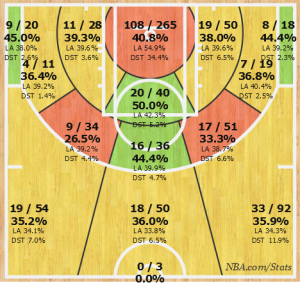2014-15 in Review: Deron Williams
Coming off career lows in playoff shooting percentage, minutes played and assists, Deron Williams finished the 2015 campaign on a low. The lackluster ending to his worst season as a professional was made even worse when his head coach publicly admitted that Williams is not the player he once was.
“He’s not a franchise player anymore,” Lionel Hollins told ESPN a day after the Nets were eliminated. “He’s a good player, he’s a solid player, but I don’t think he’s a franchise player anymore. That’s just my opinion. He’s a good player. I’m proud of the way he’s bounced back and played, and there’s so much pressure on him to be a franchise player, and everybody talks about a franchise player, but we need to have a franchise team.”
Hollins has usually defended the point guard since he arrived in Brooklyn, but the same could not be said of his former teammate, Paul Pierce. The Washington forward told ESPN that Williams hasn’t handled the national spotlight well and stopped looking like the point guard that dominated in Utah.
“Before I got there I looked at Deron as an MVP candidate. But I felt once we got there, that’s not what he wanted to be. He just didn’t want that,” Pierce said in April.
The strong words from a former teammate and current head coach confirms what the stats have been showing since Williams was traded to Brooklyn in 2011. While his production declines, the payment on his contract only increases, despite the fact that he’s already the 10th highest paid player in the league.
Despite a regular season where he recorded the worst field goal percentage of his career, Williams made $19.7 million this year and that’s slated to increase to around $21 million in 2015-16. The good news for the Nets is that he becomes increasingly trade-able when his contract reaches its final year.
Defensively, Williams has shown signs of aging when closing out on shooters. Opponents are shooting 45 percent from the field on baskets guarded by Williams, which is a slight decline from last season.
The silver linings are there for Williams, who will soon turn 31. He has shown that he isn’t the 20-point scorer from earlier in his career. However, there’s a possibility that his game can stabilize next year.
His assist-to-turnover ratio during the regular season was the highest that it’s been since 2010, the same year that he was voted as the best point guard in the league by GM’s. Yet his offensive success may be rediscovered by being in fewer ball handling situations or better embracing his role as a passer.
In a season that saw his usage go up from 2013, Williams made the lowest percentage of the team’s field goals in his career. Fortunately, he also attempted the lowest percentage of the team’s attempts in his career, meaning that efficiency is possible if Williams changes where and when he gets his shots.
If the Nets were able to add another pass-heavy ball handler in the offseason, Williams can buck the trend of pullup jump shots that marred his percentages in Brooklyn. Last season, he had the second-highest amount of unassisted field goals of his career. In his impressive 2010 season, Williams made just 53 percent of his field goals in the same situation compared to 62 percent this season.
Like most aging players, increasing the spot-up situations for Williams could prove beneficial for his scoring. But having another player to run the offense at times would help Williams to define his role easier while on the court.
While handling the ball, Williams decreased his turnover rate this season, but began to struggle when pick-and-rolls ended in unassisted jump shots. His highest frequency of shot type this season was pull-up jumpers, and he boasted just a 36 eFG% on those shots. On the other hand, he shot his highest effective field goal percentage (61.8%) in catch and shoot situations.
It’s hard to look at William’s production during his time with the Nets and think that brighter days are ahead for the aging point guard. Yet if the Nets, and Williams, can accept his status as a “solid player” instead of a franchise cornerstone he can find a more beneficial role. Who the front office decides to bring in to bolster the backcourt this offseason could decide whether his production continues to decline or if he can redefine his playstyle on his way to a bounce back year.
